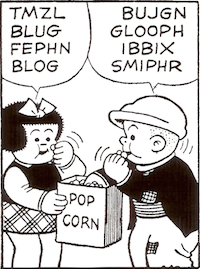Ellington was a dance-band impresario who played no better than O.K. piano, got trapped for years playing “jungle music” in gangster nightclubs, and at his height produced mostly tinny, brief recordings.
Sounds like an Amazon troll, but it’s Adam Gopnik, writing about Duke Ellington in
The New Yorker (December 23 and 30, 2013). This summary of Ellington’s accomplishments (followed by words of praise) suggests a writer who doesn’t understand Ellington’s accomplishments — as the leader of a highly idiosyncratic ensemble, as an instrumentalist, as a composer, as an early master of the recording studio. Though “tinny” might make sense if Gopnik’s experience of early Ellington is limited to major-label digital remastering.
And that’s the problem: Gopnik’s understanding of his subjects — Ellington and jazz — is limited. That’s a polite way of saying that Gopnik doesn’t know what he’s writing about.
Concerning Louis Armstrong:
He was not just a genius but an irresistible lion. Even the old complaints about his having sold out no longer seem credible: he simply went from making most of the best jazz records ever made to making some of best pop records.
“Most of the best jazz records ever made”: really? What’s glaringly wrong here though is the claim that Armstrong was charged with selling out. The surprise success of “Hello, Dolly!” was, if anything, a cause for celebration among those devoted to pre-rock-and-roll styles of music. (Armstrong dethroned the Beatles.) The real complaint about Armstrong (utterly mistaken, to my mind) was that he was an Uncle Tom, smiling and servile.
Concerning Ellington’s musicians:
The individual players he employed weren’t up-to-date urban players but, often, less sophisticated New Orleans musicians, whose great gift was a distinctly human tone, often achieved with the use of homemade mutes and plungers.
Ahh, primitivism. This claim is, by any measure, false. I can think offhand of just two New Orleans Ellingtonians: Barney Bigard (clarinet) and Wellman Braud (bass), both consummate musicians. Bubber Miley (cornet and trumpet) and Joe “Tricky Sam” Nanton (trombone), whose mute and plunger styles were crucial parts of Ellington’s “jungle” sound, were from South Carolina and New York.
Concerning Billy Strayhorn’s contributions:
It’s long been known by fans that many of the most famous “Ellington” numbers are really the arranger Billy Strayhorn’s, including “Take the A Train” and “Chelsea Bridge.”
Strayhorn was a composer and co-composer. Ellington referred to him as his “writing and arranging companion.” The implication here is that knowledge of Strayhorn’s authorship was inside information. That’s nonsense. There are countless live recordings in which Ellington says something along these lines: “And now our theme, Billy Strayhorn’s ‘Take the “A” Train.’” And the
A takes quotation marks.
Concerning the way in which Ellington musicians may have created phrases that became material for Ellington compositions:
What [the alto saxophonist] Johnny Hodges was doing in making those new melodies may have been more like the copying errors in ceaseless cell fission than like premeditated decision: as he set to playing the same chord changes over and over, night after night, a lucky error in a note may, one night, have touched another and become an innovation.
Well, Johnny Hodges didn’t make mistakes. But also: I doubt that any improvising musician would recognize in Gopnik’s imaginings a description of how improvisation and composition work.
It’s sad to see such ill-informed writing about music in the magazine that once gave
Whitney Balliett a home.
Related reading
All OCA
Duke Ellington posts (Pinboard)
Two Bands (The bit of Gopnik’s piece that’s not behind the
New Yorker paywall)
[I haven’t yet read Terry Teachout’s
Duke: A Life of Duke Ellington, the book that Gopnik is reviewing. The pages of
Duke I’ve sampled in Google Books read like a pastiche of previous writing on Ellington. I am happy though to see Ellington holding a Mongol pencil on
the book’s cover.]





